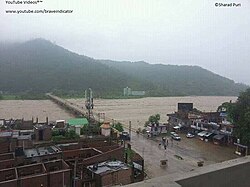West Rapti River
| West Rapti Kuwano | |
|---|---|
 West Rapti river at Bhalubang | |
| Location | |
| Country | Nepal, India |
| Physical characteristics | |
| Source | |
| • location | Rapti Zone, Nepal south of border of Rukum District with Rolpa District |
| • coordinates | 28°28′33″N 82°52′44″E / 28.4757°N 82.8788°E |
| • elevation | 3,500 m (11,500 ft) |
Ghaghara River | |
• coordinates | 26°17′20″N 83°40′08″E / 26.289°N 83.669°E |
• elevation | 60 m (200 ft) |
| Basin size | 23,900 km2 (9,200 sq mi) |
| Discharge | |
| • average | 136 m3/s (4,800 cu ft/s) |
| Basin features | |
| River system | Ganges |
| Tributaries | |
| • left | Lungri Khola, Jhimruk Khola, Ami River, Rohini River |
| • right | Arun Khola, |
The West Rapti, also known as the Kuwano, is a river which drains Rapti Zone in Mid-Western Region, Nepal, then Awadh and Bhojpur-Purvanchal regions of Uttar Pradesh state, and finally India before joining the Ghaghara. It is a major left bank tributary of the Ganges, and is also known as the Karnali in Nepal.
The West Rapti is notable for janajati ethnic groups – Kham Magar among its highland sources and then Tharu in Inner Terai Deukhuri Valley, for its irrigation and hydroelectric potential, and for recurrent floods that led to its nickname "Gorakhpur's Sorrow".
Max depth 8.50
Min depth 10.7
History
As ancient Airavati river
Aciravati, Achirvati or Airavati is the ancient name for a river has been identified with the modern Rapti, flowing through what is now Nepal and the northern portion of Uttar Pradesh.[1][2] The Chinese pilgrim Xuanzang knew it as A-chi-lo. Jain texts mention it as Eravai.[2]
The ancient city of
Geography
The Rapti rises south of a prominent E-W ridgeline midway between the western
Hydrology
The Rapti's headwaters descend south from rugged highlands populated by
Jhimruk Kholā (
Below Cherneta the Jhimruk loops east, becoming the border between Pyuthan and
bridges the river.Below Bhalubang,
The river crosses from Dang into
Just west of the city it is joined by the smaller
Resource utilisation
The Rapti's flow has great seasonal variation because the river lacks sources in high elevation glaciers and snowfields to buffer pre-monsoon drought. Average monthly flows at Jalkundi (27°58'N, 82°14'E) in Deukhuri Valley vary from 17.6 m3/s in pre-monsoon April to 451 m3/s at the peak of the monsoon in August. Maximum recorded flood was 7,390 m3/s on 10 September 1981. 100-year flood flows are predicted at 10,100 m3/s. Every year, floods threaten over 700,000 acres (280,000 ha) in Uttar Pradesh.[citation needed]
Flood control projects under study include a dam at Jalkundi that would inundate 71,000 acres (29,000 ha) of farmland in Deukhuri Valley. An alternative dam site is upstream at Naumure on the Pyuthan-Dang district border (27°53'N, 82°48'E). This would be an earthen dam 169 m high with 351 million cubic meters live storage capacity, storing excess monsoon flows for irrigation use during the following dry season and generating up to 207 megawatts. Impoundment would mainly be in gorges through the Mahabharat Range, inundating less farmland than the Jalkundi alternative. Plans are also underway for three irrigation sub-projects – Kapilvastu District 30,500 hectares (75,000 acres) involving interbasin water transfer to the southeast, Deukhuri Valley 9,500 hectares (23,000 acres), and Banke District 40,000 hectares (99,000 acres).[8]
References
- S2CID 161844172. Retrieved 10 March 2011.
- ^ )
- ^ W. Hoey. "The Five Rivers of the Buddhists". Journal of the Royal Asiatic Society of Great Britain and Ireland 1907, pp. 41-46. Retrieved 18 August 2010.
- ^ "Rapti River". india9. Retrieved 28 May 2010.
- ^ "Basti". Basti district administration. Retrieved 30 May 2010.
- ^ "Sant Kabir Nagar district". Sant Kabir Nagar district administration. Retrieved 30 May 2010.
- )
- )
External links
 Media related to West Rapti River at Wikimedia Commons
Media related to West Rapti River at Wikimedia Commons
